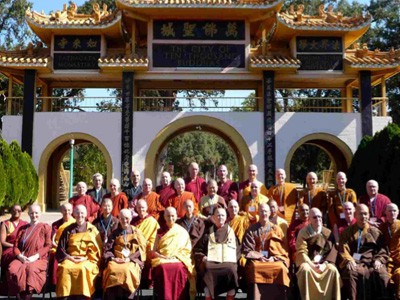Monastics go green
Treating planet Earth with non-greed, gratitude, and simplicity

Report on the 15th annual gathering of Western Buddhist monastics, held at City of Ten Thousand Buddhas in Ukiah, California, in 2009.
Each year, for 15 years now, Western Buddhist monastics from diverse Buddhist traditions have been gathering together for four or five days to share our Dharma understandings and to support each other in Dharma practice. This year, 40 monastics from the Thai forest tradition, Sri Lankan Theravada tradition, Chinese Ch’an and Pure Land traditions, and Tibetan traditions gathered together at City of Ten Thousand Buddhas in California. Unlike other gatherings inwhich we discussed a theme specifically related to monastic life, this year our gathering was entitled “Monasticism and the Environment: Treating Planet Earth with Non-greed, Gratitude, and Simplicity.” Our presenters and their topics included:
- Bhikkhu Bodhi discussed the possibilities for responding to global warming and climate change, saying that as a society we need to change our ideas about the meaning of economic progress so that it corresponds with the reality we face of an increasing population living on a planet with limited natural resources. He also shared with us the work of Buddhist Global Relief, an organization of Buddhists specializing in combating hunger and malnutrition worldwide.
- Ajahn Sona spoke about alternative technologies, sharing with us information ranging from the newest LED light bulbs to solar energy, biofuel gasification, and classy compost toilets.
- Bhikshuni Heng Yin addressed environmental education in schools. As the principal of the school at City of Ten Thousand Buddhas, she is uniquely qualified to do this. One of her students aided in her presentation, so we heard what caring for the environment from a Buddhist perspective means to the younger generation.
- Ven. Tenzin Chogkyi spoke on “eco-anxiety,” the distress that we feel when we learn of the destructive effects of human activities on the environment. This topic came up repeatedly in the conference, as we realized how important it is to counteract the sense of futility that causes us to slide into despair and apathy and to replace it with an optimistic and energetic attitude to do our best to alleviate suffering.
- Ayya Tathaaloka introduced key issues in the genetic engineering of foods, animals, and human beings. Is it a blessing or a curse? How does genetic engineering relate to our Buddhist aims of compassion and reducing suffering?
- Rev. Heng Sure spoke on the Buddhist attitude towards the treatment of animals. Together with this we saw a film about animal liberation by a Buddhist temple in Canada.
- Ven. Jian Hu told of the little-known fact that the meat industry contributes more to greenhouse gases and water pollution than all the cars, trucks, and planes in the world. This occurs due to the fertilizers used to grow the animal feed as well as from animal excrement and the methane produced in their digestive system. Becoming vegetarian is good not only for reasons of health and compassion, but also for environmental ones. As a result Sravasti Abbey will start a “Vegetarian from Afar” program, similar to our “Retreat from Afar” in which we’ll encourage people to be vegetarian—even for one day a week if that’s what they feel comfortable with—in order to protect the environment and prevent animals from suffering. Participants will send their pictures to us and we’ll put them in our kitchen/dining area so that they’ll know they are part of the Abbey community that cares about the environment and the well-being of animals.
The Buddha spoke not only about inner spiritual cultivation, but also about important social issues of his time. As monastics who follow in his footsteps, we know that we can play an important role in informing people about global warming and destruction of the natural environment as well as in encouraging people to be proactive to prevent this and to preserve the environment. As citizens, we must do what we can on a personal level—from changing lightbulbs to recycling to carpooling—but we must also do what we can as employers and employees of major industries. We must each do what we can in our own fields as well as communicate with those who make policies in other areas.
In the evenings we watched films about the environment: Renewal was about the inspiring efforts undertaken by various religious congregations in the US to protect the environment and the living beings in it. Crash Course was a challenging and informative presentation on the intersection of the economy, energy sources and usages, and environment. It had hints of what could lie ahead and how to deal with it. While difficulties will arise, it gives us a great opportunity to act and benefit society with compassion and bodhicitta.
In addition to all these fascinating presentations, we had a tour of City of Ten Thousand Buddhas and also a tour of nearby Abhayagiri Monastery. All of us use the Vinaya—the Buddhist monastic code of precepts and guidelines—to guide our lives. Within this commonality, it’s fascinating to see the variety Buddhist monastics lifestyles—some live together in dorms while others in isolated huts, some engage in social welfare projects while others emphasize study or meditation. We also shared in the community life of the residents of CTTB, with group with meditation and chanting in the morning and evening. I especially enjoyed chanting “Namo Amitofu”—Homage to Amitabha Buddha—as we all did walking meditation in a single line in the Buddha hall. Doing this with the children in the school was especially touching.
The CTTB community—about 200 people in all—said they were inspired by our gathering. In turn, we received so much hospitality from them—the monastics who organized the conference and the lay volunteers who worked tirelessly to help us as much as they could. While the theme of the conference is important, just being together as sangha is wonderful and powerful. Our personal and small group discussions in the break times create strong bonds. They give junior monastics a chance to seek practice advice from seniors in other traditions; they provide monastics who live alone and those who live in community the opportunity share experiences. We had interesting discussions about the ultimate nature and how to realize it arise, as well as conversations about how to follow our spiritual mentor’s instructions and how to interpret certain precepts in a modern society. The feeling of unity we have as a “Sangha of the ten directions” is palpable and something that would please the Buddha. In previous centuries the various Buddhist traditions had little contact with each other due to geographical separation and the absence of modern means of communication. As a result they had many misconceptions about each other. Western monastics want to do things differently because now people from diverse Buddhist practice lineages live together in Western countries. Thus we gather each year in friendship, aiding each other in building monastic communities, practicing the Dharma, teaching Buddhism, and benefiting society. This is a cause for great rejoicing.
Venerable Thubten Chodron
Venerable Chodron emphasizes the practical application of Buddha’s teachings in our daily lives and is especially skilled at explaining them in ways easily understood and practiced by Westerners. She is well known for her warm, humorous, and lucid teachings. She was ordained as a Buddhist nun in 1977 by Kyabje Ling Rinpoche in Dharamsala, India, and in 1986 she received bhikshuni (full) ordination in Taiwan. Read her full bio.


